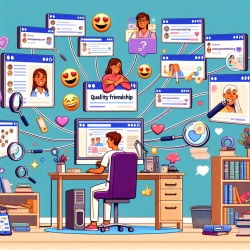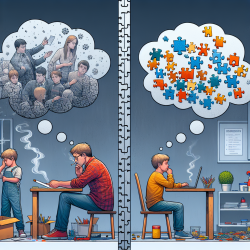Introduction
In the ever-evolving field of speech-language pathology, staying informed about cutting-edge research is crucial for practitioners aiming to improve therapeutic outcomes. The recent study titled "Theoretical prediction of two-dimensional BC2X (X = N, P, As) monolayers: ab initio investigations" offers fascinating insights into the potential applications of novel 2D materials. This blog explores how these findings can inform and enhance your practice, particularly in the realm of online therapy services provided by companies like TinyEYE.
Understanding BC2X Monolayers
The research conducted by Bafekry et al. (2022) delves into the properties of BC2X monolayers, a new class of two-dimensional materials. These monolayers, consisting of boron, carbon, and a third element (nitrogen, phosphorus, or arsenic), exhibit unique structural, electronic, and optical characteristics. The study employs density functional theory to predict these properties, providing a theoretical foundation for future experimental work.
Key Findings and Their Implications
- Stability and Mechanical Properties: The BC2X monolayers are stable and exhibit a brittle nature. This stability is crucial for potential applications in electronic and optical devices.
- Electronic Properties: These monolayers are semiconducting with indirect bandgaps, making them suitable for nanoelectronic devices.
- Optical Properties: The materials show significant absorption in the ultraviolet range, indicating potential for use in UV light applications.
- Photocatalytic Applications: BC2N and BC2P monolayers are promising candidates for photocatalytic water splitting, a process relevant to clean energy production.
Integrating Research into Practice
For practitioners in speech-language pathology, understanding the implications of such materials may seem distant from daily practice. However, the integration of advanced materials in technology can enhance the tools and platforms used in online therapy. For instance, improved electronic and optical properties can lead to better communication devices and software, enhancing the delivery of therapy services.
Moreover, staying informed about such advancements ensures that practitioners can advocate for and adopt the latest technologies that improve client outcomes. Encouraging further research and collaboration with material scientists can lead to innovations that directly benefit therapeutic practices.
Encouraging Further Research
Practitioners should not only implement existing research findings but also contribute to the ongoing dialogue in scientific communities. By collaborating with researchers and participating in interdisciplinary projects, speech-language pathologists can help shape the future of therapeutic technologies.
Conclusion
The study of BC2X monolayers opens new avenues for research and application in various fields, including speech-language pathology. By understanding and integrating these findings, practitioners can enhance their skills and improve outcomes for their clients. To delve deeper into the original research, Theoretical prediction of two-dimensional BC2X (X = N, P, As) monolayers: ab initio investigations.










